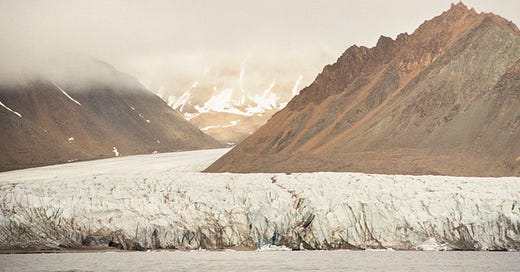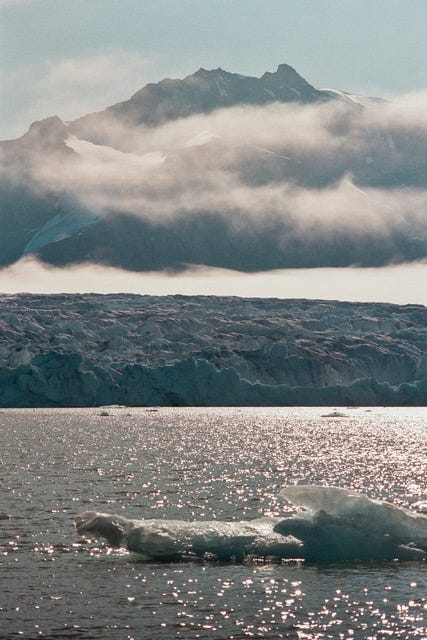Maria is a German South-African travel writer and photographer with two Masters in Environmental Humanities and Nature & Travel Writing. The concepts of time and memory fascinate her, as do more-than-human voices in human stories. She finds her greatest inspiration in wild spaces.
My kayak glides quietly across the waters of the bay. The sky is completely cloudless, a rare occurrence here in Svalbard, and the bay is so calm we could be rowing across a burnished silver plate. All around us rise the snow-clad mountains, bathing in the cool water. The summer heat undresses them, until their limbs are draped only in white ribbons.
My oar eases through folds of silken water. There is no sound but for our groups’ low murmur of voices, our guide’s gentle instructions. An occasional laugh. The distant call of a kittiwake.
Slowly we inch our way, in our bright toy boats, across the wide silver bowl of the cove. The closer we get to the mountains, the more ice floats towards us. Small icebergs drift by, gleaming in the sun, swooping up into leaping dolphins, birds and palace gates. Silhouetted behind loom the black knives of the mountain.
We round the last bend in the crook of the bay and there, ahead of us, easing between thighs of rock, a great river of ice inexorably bent towards the sea. The glacier must be about fifty metres high, one chunky slab of white against a sheet of sky. Its face is chipped and flaky like roughly hewn cheese, or chocolate, or – I cannot think why the only words that come to me are food, but that this is something essential I am seeing, something all-consuming, something being consumed. Its scars, where it most frequently calves, are cerulean, electric. A crack thunders from the depths of the glacier, like a giant’s knee popping. We all gasp and look at each other, eyes wide, mouthing Wow.
A lone arctic tern swoops directly over my head, plunging towards the glacier, its thinly pointed, elegant wings etched white against the sky, disappearing from sight in the mass of ice.
With difficulty we turn away. Before us now lies a field of brash ice – thousands of tiny chunks of ice shed from the glacier, gathered in the bay’s embrace. Our path takes us straight through.
The moment our kayaks hit the field, a great din of crunching ensues. Our oars scrunch through the dense drift ice with a sound much like a straw in a slushy, and the bigger pieces thump against the hull in delightfully ominous knocks.
We exit the ice field, breathless from exertion and laughter.
Our endpoint lies ahead, the crew waiting in zodiacs to help us out of our kayaks, hot chocolate and Bailey’s at the ready to warm our freezing hands.
A fulmar, distant cousin of the albatross, flies an inch over the water, dipping the tip of its right wing into its reflection in greeting.
It flies on towards the shore, to the craggy cliffs where a bird colony has made its home.
The bird cliffs tower above us, unusually green in this barren landscape, fertilised by centuries of guano. The sun cuts itself into white-gold slivers on the knife’s edge of a peak. Everywhere are birds. Fulmars and kittiwakes burn golden for a slow moment as they glide across the rim from shadow into light. Black guillemots stumble through the air on tiny white triangles of wing that seem too small for their bodies. Here, a puffin whizzes past like a hovercraft, and there, an arctic tern spins mid-air to plunge into the blue.
The noise is astounding. It is as though they are all spectators in a colossal stadium, sitting row upon row on their perches, shouting and cheering and whistling at us – the gladiators in our odd yellow containers, floating in the grand arena of the bay.
But beneath the shrieking and screeching, there throbs a constant, pulsating hum of sound, nearly inaudible but unquestionably there. It is like a drumbeat, like a beehive thrumming with pent-up energy ready, at any moment, to erupt. Is it a call of the guillemots? Is it the fusion of a thousand voices funnelled into one pulse of pure energy, pure sound? Or simply the sound of life? All I can do is sit there in my little kayak, ear cocked, smiling in wonder.
I reach down into the water and scoop up a chunk of black ice. In the water it looks dark, transmitting the depths of the bay, but in my hands it is completely translucent. Our guide estimates it to be two thousand years old. Two thousand years of compression have squeezed out nearly all the air bubbles, all the whiteness, leaving behind only light. Thin lines of silver snake through the ice, ballooning into tiny, crystal-clear bubbles here and there. I hold a diamond in my hands. Two thousand years are melting in my bare, pink hands.
I can’t resist – I lick it.
It feels sacrilegious, but I feel an urge to consume, to have a small part of this ancient water, young when the Romans reigned, become a part of me. It tastes like nothing, like absolutely nothing. It tastes like the purest thing, melting on my tongue.
The Timbuktu Review is a gathering one-pot cooking, a convenient store that sells both gas and chicken, a place where text mixes with curiosity and experiences, an attempt to convey connections through forms that are inaccessible to the rational mind but intuitively recognizable as making sense. Analog travel and the human written word. It is also a selfish act of wanting to read our friends, so this becomes a gathering spot for a literary community, a village flagpole, a place to staple an idea or thought up and say to all “read this, it is a human thought with all its foibles”.
Something to share? Keen on writing an essay, a wee missive?
Send submissions to thetimbuktureview@substack.com and we will take a gander to see if it fits. Travel writing can be so many things. It can be poetry, fiction, a graphic novel, creative nonfiction, magic surrealism, a children's book, anything that captures that feeling we all get when we leave our homes and go out into the world and are curious. If wondering what themes to write, it is anything that loosely touches that feeling we get at a train station.







